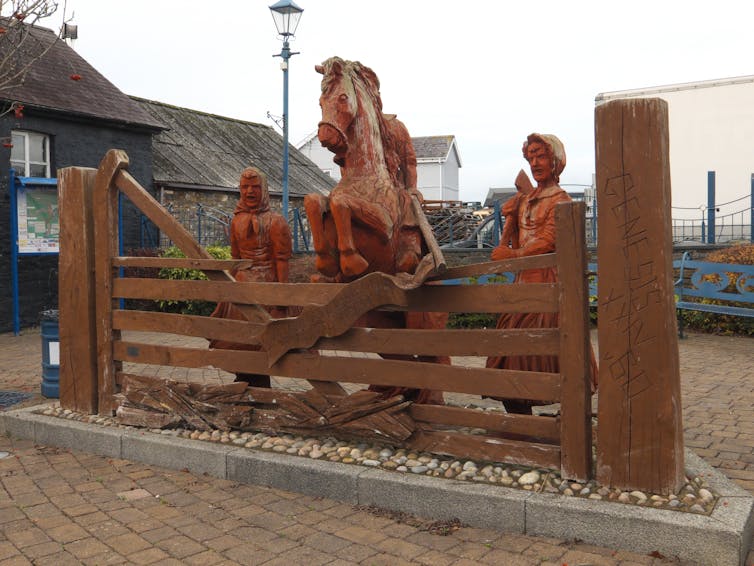Lowri Ann Rees
Senior Lecturer in Modern History
South-west Wales was reeling in the wake of social unrest in November 1843. There had been a series of protests over several years by farmers furious at taxation levels, mainly attacking tollgates. Often, the men involved dressed as women and were therefore known in Welsh as Merched Beca (Rebecca’s daughters). The events that unfolded came to be known as the Rebecca riots in English.
There has been speculation that the name “Rebecca” stemmed from a literal interpretation of Genesis 24:60 in the Bible, which refers to Rebekah’s offspring possessing the gates of their enemies. But the truth is, nobody really knows why the name was chosen.
Tollgates had been introduced in Britain from the late 17th century as a means of raising revenue to maintain public roads. They were regulated and maintained by the Turnpike Trusts, individual bodies set up by parliament.
Tolls had long been regarded as a burden by the people. But complaints to magistrates about their unfair regulation were largely ignored. The tollgates therefore became regarded as symbols of oppression to be demolished by the Rebeccaites, with unrest largely concentrated across Carmarthenshire, Cardiganshire and Pembrokeshire.
The first recorded appearance of Rebecca was on May 13 1839, when a tollgate at Efailwen in Pembrokeshire was demolished. Rebecca emerged again during the winter of 1842, with protests intensifying throughout the summer of 1843.
The attacks targeted tollgates and private property, while toll-keepers and authority figures were also intimidated. These included the local gentry, who upheld law and order locally as magistrates and oversaw the administration of the tolls as members of the Turnpike Trusts.
Those who protested were predominantly young men who were tenant farmers, farm servants and agricultural labourers. But other protesters included non-agricultural labourers from industrialised regions of Carmarthenshire and neighbouring Glamorgan.
A striking element of the protest was the adoption of women’s clothing to conceal the identities of those involved. This was theatrically woven into the ritual of protest as “Rebecca”, the name given to the leader of the various protests, called on her children to tear down any gate that blocked their way.
However, the Rebecca riots were more than just a protest movement against the tolls. They were also a reaction to the socio-economic climate, to agricultural depression, failing harvests, rising levels of rent and the weight of various taxes. All these factors collectively placed substantial pressure on rural communities.
There was also widespread criticism of the administration of the new Poor Law, introduced in 1834, which ensured that poor people were housed in workhouses, where families were separated, subjected to hard work and harsh living conditions.
Escalation
On June 19 1843, a procession in the market town of Carmarthen led to the storming of the workhouse. This signalled a turning point that saw the protests intensify, with attacks on private property in addition to tollgates.
There were reports of physical violence and use of firearms too, with one recorded death, that of Sarah Williams, the 75-year-old keeper of the Hendy tollgate in Carmarthenshire. Someone shot her while she tried to rescue her belongings from the burning tollhouse on September 9 1843.
Following the Carmarthen workhouse attack, The Times newspaper sent Thomas Campbell Foster to report on “The State of South Wales”. His reports disseminated news of Rebecca and her daughters across Britain.
Even Queen Victoria was concerned by the events. She wrote in her journal how she strongly advised the home secretary, Sir James Graham, to apprehend and punish the Rebeccaites. She feared events in Wales would spur on the movement in Ireland to repeal the laws which tied Ireland to Great Britain.
Into the autumn and winter months of 1843, Rebecca and her daughters appeared less frequently. Although a Carmarthenshire land agent, Thomas Herbert Cooke, wrote in late November how “an incendiary fire however occurs now and then to let people know that Rebecca is still alive, and sometimes awakes from her slumbers”.
Government inquiry
During this time, a government inquiry was conducted into the causes of the riots, reporting its findings in the spring of 1844. Although the tollgates survived, the findings of the inquiry led to greater regulation of the Turnpike Trusts in Wales. New county police forces were also established in the wake of the riots.
In total, around 250 tollhouses and gatehouses were destroyed by Rebecca. In the aftermath, those captured and accused were punished by transportation to the penal colonies in Tasmania. Those such as John Hughes, known as Jac Ty Isha, were never to return to their native Wales. Others took on an almost mythical identity among local people, such as Thomas Rees, or Twm Carnabwth, remembered as the leader of the first Rebecca attack at Efailwen.

However, Rebecca did not disappear entirely, and instances of protest and threatening letters sent in her name appear later in other parts of Wales. During the 1870s, Rebecca and her daughters appeared in protests concerning salmon poaching on the river Wye in mid Wales, described as the “second Rebecca Riots”.
In the 20th century, the concept of Rebecca was invoked once more. In 1956, Welsh language newspaper, Y Seren, inferred that “the spirit of Beca” was once again needed to campaign against the flooding of Cwm Tryweryn in Gwynedd to create a reservoir to provide drinking water for Liverpool.
And Rebecca continues to resonate in Wales to this day, inspiring re-enactments and community engagement – it shows that the fight for justice and the tradition of protest continues to play a powerful part in Welsh society.
This article is republished from The Conversation under a Creative Commons license. Read the original article.









